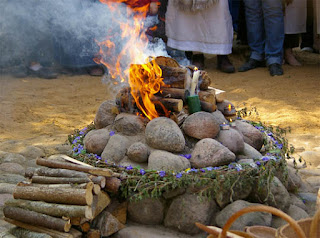There is a great deal of controversy in scholarly circles about the differences between the mystic path and the shamanic path. While there is no precise answer, in this post I will compare the similarities and differences. Both paths place great emphasis on personal experience derived from introspection and self-observation. Though they differ significantly in their approach, practitioners of both traditions seek accord with nature through consciousness-altering techniques. We do not know how old each of them is, but evidence suggests that the shamanic path is older. Shamanism has been around for tens of thousands of years and has played a functional role in human survival and cultural evolution.
Shamanism is based on the principle that innate wisdom and guidance can be accessed through the inner senses in ecstatic trance induced by shamanic practices such as repetitive drumming. Ecstatic trance is an academic term referring to those inwardly focused experiences of cosmic oneness, that mystical connection to a living, intelligent universe that exists within each of us. Practitioners enter altered states of consciousness in order to perceive and interact with the inner world of the self. The act of entering an ecstatic trance state is called the soul flight or shamanic journey. A shaman is a practitioner who has developed the mastery of accessing altered states of consciousness to gain wisdom, healing techniques, and other vital information that can benefit the community. The shaman traverses the inner planes in order to mediate between the needs of the spirit world and those of the material world.
One major difference between the two is that mystics are often officially aligned with a religion while shamans are not. This does not mean that shamans do not practice a religion because many do. There are in fact Christian shamans, Jewish shamans and Buddhist shamans, but the religions often do not endorse their shamanic practices. In many cases they condemn it so these shamans keep their shamanic practices secret or discreet. However, every religion has a mystic tradition even though it is often an outlier that is a marginally tolerated aspect of the religion.
The roots of mysticism can be traced back to shamanic practices from the earliest tribal communities. Unlike shamans, however, mystics are practitioners of doctrinally acceptable forms of religious ecstasy (e.g., prayer, meditation, fasting) aimed at union with the divine. Mystics are dedicated to awakening, self-realization and enlightenment, and they are less concerned with mediating the needs of their communities. On the other hand, a realized master will often intuitively know how to help their community through their connection with nature and the divine. Both shamans and mystics are known for their ability to travel vast distances in an instant, to find lost articles and people, to commune with nature spirits. When shamans develop their powers through long apprenticeships and training, they can do much the same things as their mystic counterparts.
Mystics are known for both deep learning of esoteric subjects, and a deep spiritual connection with God (or whatever term you would like to use for a higher power). They are famous for their solitary retreats, their long sojourns in the wilderness fasting, cultivating wisdom, seeking to expand their awareness without any distractions. Mystics are also known for their ability to acquire and nurture ongoing relationships with wild animals in nature, to speak with them and listen to them.
Shamans are known for many of these practices as well. Of course, not all shamans are mystics. The reality is that some shamans are just on an ego trip to make money and manipulate others. Some are very powerful and effective but have no ethics or principles at all. Other shamans are great healers and spiritual leaders in their communities, but have no interest in self-realization or enlightenment.
Similarly, not all mystics are shamans. Many mystics regard shamanic practices as just more ego pursuits to be avoided. They are inclined to believe that the physical world is a deceptive illusion. For the mystic, reality is the evolution of consciousness in the alchemy of time. Reality shifts and changes like the flow of the collective unconscious, and is in constant motion creating new patterns of experience. Reality, in its illusion, is the dream from which we all awaken.
And yet there is a lot of overlap between master shamans and truly realized mystics. It could well be that the most accomplished shamans can't help but encounter the mystic path somewhere in the timeline of their learning and development? And it could be that some mystics can't help but develop shamanic powers and despite the illusory nature of the physical realm, participate in world activities just to experience it. After all, we are here on the earth to experience, learn and grow.
Shamanism and mysticism are ultimately about consciousness, about learning through attunement to nature, which is a reflection of the divine, creative power of the universe. They provide a myriad of responses to the spiritual quest of self-discovery. Both paths emphasize establishing a personal relationship with the powers of creation. By practicing these ways of being, we awaken our soul calling and our connection to nature. They are ways that embed us in the living web of life, yielding greater awareness and perspective. These practices are easily integrated into contemporary life and provide a means of navigating the turbulent times in which we live.



